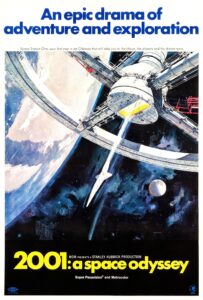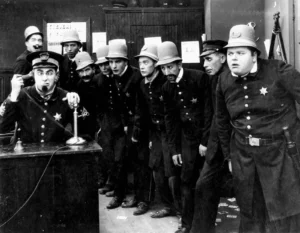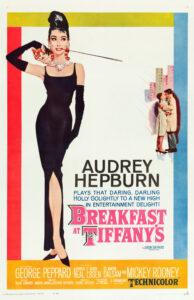1963 Atlanta, Georgia
Stephen B. Slade
1963
Atlanta, Georgia
Interviewed on February 3, 2023
by Jake Tae
I don’t recall my first movie, but the earliest most memorable movie I watched in the theater was It’s a Mad, Mad, Mad, Mad, World. I think it was my friend’s birthday party, and he all got us tickets to this movie. It was just a popular thing to do if you were a kid. You would have a birthday party and take people to the movies.

I don’t remember what the name of the theater was, but it was certainly near the Fox Theater in Atlanta. It was on Peachtree Street… everything is on Peachtree Street. The theater was very ornate, almost like a palace. There were ushers in uniform. They also had concession stands with popcorn and soda. And candies too, I guess. I used to buy raisenets. For some reason, I don’t think I saw those candies outside the theater; I don’t recall buying raisenets anywhere else. And they would come in big boxes, too.
Movie theaters these days are usually big multiplexes. We didn’t have those back then. Theaters would just have one huge screen and play one movie. Occasionally, you would have double features, where they showed two different movies back-to-back, but there was no simultaneous screening of two different movies. Theaters would simply play one movie and just play that same movie for weeks. I also don’t think they showed advertisements or trailers before the start of screening. Sometimes there would be newsreels, but that was about it.
It’s a Mad, Mad, Mad, Mad, World, I guess, was an early spectacular movie. It had very large casts, lots of stars… Spencer Tracy, Sid Caesar, Mickey Rooney, Jonathan Winters, and so on. But the main thing was how big this screen was. I don’t know how it compared to IMAX, but it was a very impressive and awesome experience. I think subsequently, at the same theater, they played the 2001 Space Odyssey. And these movies all took advantage of this new screen technology. 70 mm as opposed 45 mm cinematic units. It was awesome!

The movie was very, very long, and I think it had an intermission. It wasn’t the typical hour-and-a-half-long format we’re used to. It was common for long movies to have intermissions. They were kind of designed to replicate the theatrical experience. When I was growing up, I actually went to the theater and to the opera as well. In the winter, my family would go to New York to see the Metropolitan Opera, so I was used to the theater experience. And I remember this movie was trying to imitate the theater experience in part by having an intermission. It was also a chance for theaters to sell more popcorn.
I remember the Mad World movie pretty well because I’ve rewatched it over the years. I used to get Turner Classic Movies, and they would sometimes play it there, too. The movie takes place in a forest. There’re these crazy people trying to go and find money in the forest, and Spencer Tracy is a policeman trying to capture them. But he becomes caught in the plot as well, so it was sort of a moral tale. But in typical Hollywood style, the bad guys don’t get away with it. They all end up in a hospital with terrible broken bones. No one dies, I believe. If they did, that would have violated the laws of comedy. In Shakespeare, there’s sort of strict rules for comedy and tragedy. One of the rules is that in comedy, no one dies, and in tragedy, people do die. But another rule is that, in comedy, you start off in a civilized, urbane world, and then you go off into the nature or the wild, and then finally you end up back in the city. It’s your trip to this natural world. I think the Mad World movie might have followed that arch. The characters all try to find where this buried inheritance is. They go off in different directions: some of them drove, others took planes, and they all go through various misadventures. But I think it might have loosely adhered to the Shakespearean arch of comedy. Again, no one died.
When I rewatched the movie a few years later, I realized there is a lot of cruel slapstick in the movie. I know we’re supposed to laugh at it, but we’re laughing at people being cruel to each other. I didn’t really perceive this at all when I was watching it as a child. The same with the Three Stooges, where they slap each other again and again. Laurel and Hardy. The Marx Brothers, for that matter. Even in silent movies like the Keystone Cops or Charlie Chaplin’s pieces, there’s a lot of physical comedy that’s demeaning or insensitive. You have to have this willing suspension, not of disbelief, but of moral judgement. You can’t sit there and think, “Oh, they’re being terrible people.” You put yourself in this suspension mode, where you know it’s not real, it’s just to put on a show, and you don’t judge it by normal standards. You throw that away, and you’re in there for the laughs. But I think today, you wouldn’t see movies that engage in such excessive and abusive physical comedy.

I think the people in the movie theater were pretty diverse. There weren’t many other options for entertainment. No cable TV or VCR, and certainly no Netflix. There were just three networks: ABC, NBC, and CBS. If you want to go on a date, you go to a movie. Family nights, too. I remember my parents sometimes taking me to movies that they decided in retrospect were inappropriate, like Breakfast at Tiffany’s and Gypsy. Gypsy is about a stripper. In Breakfast at Tiffany’s, Audrey Hepburn is effectively a call girl. I don’t think we had movie ratings like we do today. There was one extreme rating called UY, or “unfit for young,” but there was no other rating as far as I recall. A few times, my mother took me to the movies and realized it was a huge mistake. Actually, I think what I remember is not going to the movies, but my mother talking afterwards how we shouldn’t have gone to the movies.

The main thing that I appreciate about movies is just the story. In fact, I actually often just like to watch the movies with my eyes closed. I just listen to it, and particularly if it’s a move I’ve seen before, I like to absorb the story and the dialogue. If you go back and look at old movies, you’ll see a lot of them have sloppy plots. The narrative is not seamless. There are loose ends; characters do things early on that they don’t remember afterwards. These days, people making movies are a lot more careful about having a smooth narrative flow so that the audience doesn’t go, “Why is this character here? What’s going on? What happened to this character? He just doesn’t show up anymore?” Clearly there were old movies that are gems; they were terrific. There’s also a lot that weren’t. When I rewatch old movies, I sometimes realize that the plot is not as seamless as modern productions. People like Spielberg and George Lukas really pushed the field. They don’t leave the viewer guessing. On average, the quality of plots has gotten better.
I don’t go to the movies as often as I did when I was younger. In more recent years, it’s mainly because of COVID. I’ve been in New Haven for a long time. Have you been to West Campus? There used to be movie theaters, like the Showcase Cinema. We would drive out to West Campus when I was in graduate school. It was a good time.
